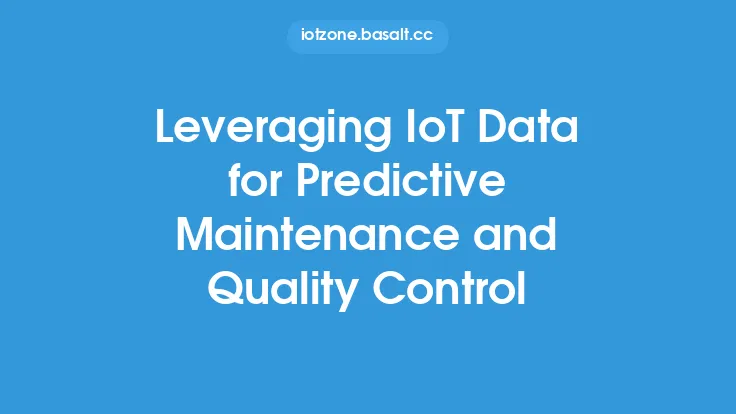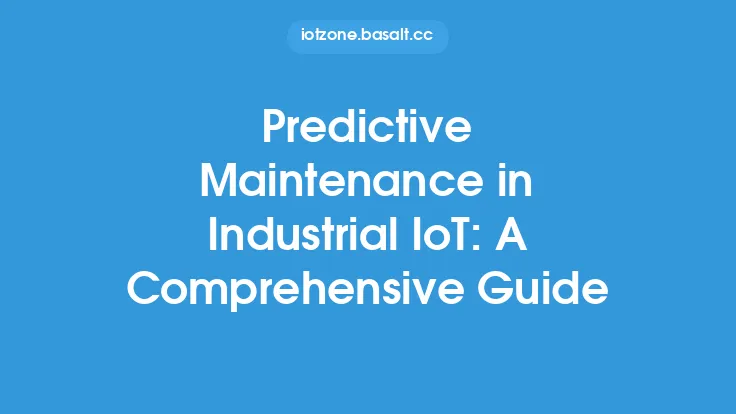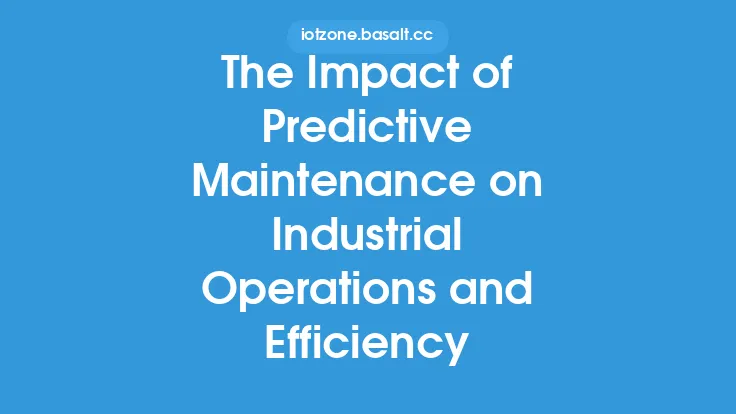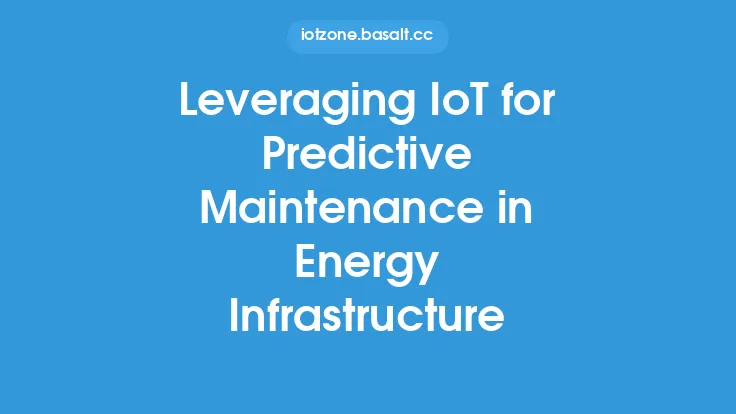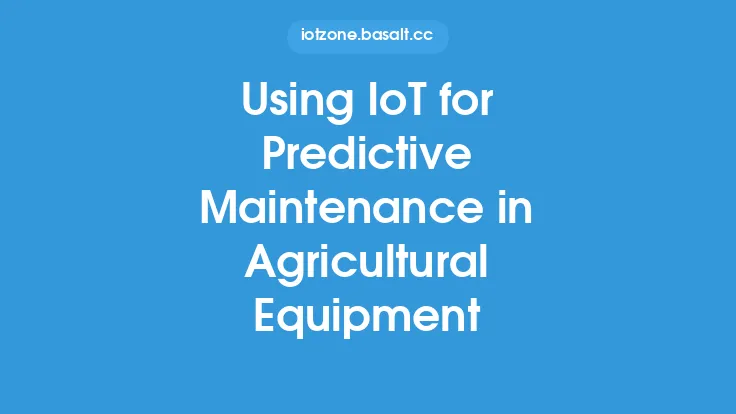The integration of the Internet of Things (IoT) and Artificial Intelligence (AI) has given rise to a plethora of innovative applications, and one of the most significant among them is predictive maintenance. Predictive maintenance is a technique that uses data and analytics to predict when equipment or machinery is likely to fail, allowing for proactive maintenance and minimizing downtime. The combination of IoT and AI makes predictive maintenance more effective and efficient, enabling organizations to reduce costs, improve productivity, and enhance overall operational efficiency.
Introduction to Predictive Maintenance
Predictive maintenance is a proactive approach to maintenance that uses advanced analytics and machine learning algorithms to predict when equipment or machinery is likely to fail. This approach is different from traditional preventive maintenance, which involves scheduled maintenance activities based on fixed intervals or usage. Predictive maintenance uses real-time data from sensors and other sources to identify potential issues before they occur, allowing for targeted maintenance activities that minimize downtime and reduce maintenance costs.
Role of IoT in Predictive Maintenance
The IoT plays a critical role in predictive maintenance by providing the necessary data and connectivity to enable real-time monitoring and analysis of equipment and machinery. IoT sensors and devices can be installed on equipment to collect data on parameters such as temperature, vibration, pressure, and flow rates. This data is then transmitted to a central platform or cloud-based application, where it can be analyzed using advanced analytics and machine learning algorithms. The IoT also enables remote monitoring and control of equipment, allowing maintenance personnel to respond quickly to potential issues and minimize downtime.
Role of AI in Predictive Maintenance
AI is a key enabler of predictive maintenance, as it provides the advanced analytics and machine learning capabilities necessary to analyze the large amounts of data generated by IoT sensors and devices. AI algorithms can be trained on historical data to identify patterns and anomalies that indicate potential equipment failures. These algorithms can also be used to predict the likelihood of failure and provide recommendations for maintenance activities. Additionally, AI can be used to optimize maintenance schedules and resource allocation, ensuring that maintenance activities are performed at the most effective time and with the minimum amount of resources.
Technical Overview of Predictive Maintenance
From a technical perspective, predictive maintenance involves the use of advanced analytics and machine learning algorithms to analyze data from IoT sensors and devices. The process typically involves the following steps:
- Data collection: IoT sensors and devices collect data on equipment parameters such as temperature, vibration, and pressure.
- Data transmission: The collected data is transmitted to a central platform or cloud-based application.
- Data analysis: Advanced analytics and machine learning algorithms are applied to the data to identify patterns and anomalies that indicate potential equipment failures.
- Prediction: The algorithms predict the likelihood of failure and provide recommendations for maintenance activities.
- Optimization: The maintenance schedule and resource allocation are optimized to ensure that maintenance activities are performed at the most effective time and with the minimum amount of resources.
Benefits of Predictive Maintenance
The benefits of predictive maintenance are numerous and significant. Some of the most notable benefits include:
- Reduced downtime: Predictive maintenance enables proactive maintenance activities that minimize downtime and reduce the likelihood of equipment failures.
- Improved productivity: By minimizing downtime and reducing maintenance costs, predictive maintenance can improve overall productivity and efficiency.
- Cost savings: Predictive maintenance can help reduce maintenance costs by minimizing the need for costly repairs and replacements.
- Enhanced safety: Predictive maintenance can help identify potential safety hazards and prevent accidents by predicting equipment failures and enabling proactive maintenance activities.
Real-World Applications of Predictive Maintenance
Predictive maintenance has a wide range of real-world applications across various industries, including:
- Manufacturing: Predictive maintenance can be used to monitor and maintain manufacturing equipment, reducing downtime and improving productivity.
- Oil and gas: Predictive maintenance can be used to monitor and maintain oil and gas equipment, reducing the likelihood of equipment failures and improving overall safety.
- Transportation: Predictive maintenance can be used to monitor and maintain vehicles, reducing downtime and improving overall efficiency.
- Healthcare: Predictive maintenance can be used to monitor and maintain medical equipment, reducing downtime and improving overall patient care.
Challenges and Limitations of Predictive Maintenance
While predictive maintenance offers numerous benefits, there are also several challenges and limitations to consider. Some of the most notable challenges include:
- Data quality: Predictive maintenance requires high-quality data to be effective, which can be a challenge in environments where data is limited or of poor quality.
- Algorithm complexity: The algorithms used in predictive maintenance can be complex and require significant expertise to develop and implement.
- Integration: Predictive maintenance requires integration with existing systems and infrastructure, which can be a challenge in environments where systems are legacy or outdated.
- Security: Predictive maintenance requires the use of IoT sensors and devices, which can introduce security risks if not properly secured.
Future of Predictive Maintenance
The future of predictive maintenance is exciting and rapidly evolving. Some of the most notable trends and developments include:
- Increased use of AI and machine learning: The use of AI and machine learning in predictive maintenance is expected to increase, enabling more accurate and effective predictions.
- Greater emphasis on edge computing: Edge computing is expected to play a greater role in predictive maintenance, enabling real-time analysis and decision-making at the edge of the network.
- Increased use of IoT sensors and devices: The use of IoT sensors and devices is expected to increase, enabling more widespread adoption of predictive maintenance.
- Greater emphasis on cybersecurity: Cybersecurity is expected to become a greater priority in predictive maintenance, as the use of IoT sensors and devices introduces new security risks.
Conclusion
In conclusion, the combination of IoT and AI has given rise to a powerful new approach to maintenance known as predictive maintenance. Predictive maintenance uses advanced analytics and machine learning algorithms to predict when equipment or machinery is likely to fail, enabling proactive maintenance activities that minimize downtime and reduce maintenance costs. While there are challenges and limitations to consider, the benefits of predictive maintenance are numerous and significant, and the future of this technology is exciting and rapidly evolving. As the use of IoT and AI continues to grow and evolve, we can expect to see even more innovative applications of predictive maintenance in the years to come.

